TOGAF ADM Software: ADM Step-by-Step Tutorial
Enterprise Architecture is essential to every business, but it’s not always easy to master. However, don’t let that discourage you. With Visual Paradigm’s help, you can learn Enterprise Architecture on your own. Be a TOGAF pro, simply go through this tutorial, and witness how the best TOGAF software can make executing TOGAF activities and producing TOGAF deliverables a breeze.
What are TOGAF and TOGAF ADM?
TOGAF, short for The Open Group Architecture Framework, is a comprehensive framework that provides a detailed method and a range of tools to support the development of enterprise architecture.
One of the key elements of TOGAF is the TOGAF Architecture Development Method (ADM), an architecture method recommended by TOGAF. The ADM is a methodology for developing and managing the lifecycle of an enterprise architecture and forms the foundation of TOGAF. When we refer to TOGAF ADM or ADM, we are specifically talking about the ADM cycle shown below:
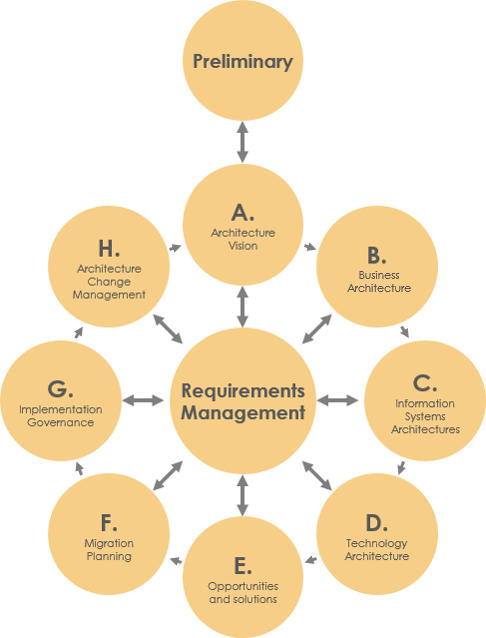
What does Visual Paradigm Offer?
As a TOGAF software, Visual Paradigm features a visual TOGAF ADM process map that provides enterprise architects with guidance on:
- Clear instructions and steps to walk through the ADM. It guides you through the development of enterprise architecture with TOGAF ADM, activity by activity, step by step.
- The tools required to complete the steps. Some examples include the ArchiMate diagram tool, ArchiMate viewpoints, roadmap diagram, maturity analysis, PERT chart, gaps analysis, RACI, and more.
- A document generation tool that generates the deliverables you need to communicate with your team and stakeholders.
Developing Enterprise Architecture with Visual Paradigm is like having a tutor sitting next to you, guiding you through the instructions and examples of the ADM. All you need to do is follow the on-screen instructions, fill in some tables and forms, draw some ArchiMate diagrams (3.0), and that’s it – the deliverables will be ready for retrieval.
How to use the TOGAF ADM Guide-Through?
The TOGAF ADM is comprised of multiple phases and activities, which makes it difficult to cover the entire cycle in one tutorial. Thus, in this tutorial, we will focus on demonstrating the use of the TOGAF ADM Guide-Through to develop the Organizational Model, during the Preliminary phase.
To prevent any impact on your existing project data, please begin by creating a new project.
At any point in the ADM cycle, you can access the ADM process navigator by selecting ITSM > TOGAF ADM from the application toolbar. This will bring up the screen below, where you can double-click on a phase to view its associated activities.
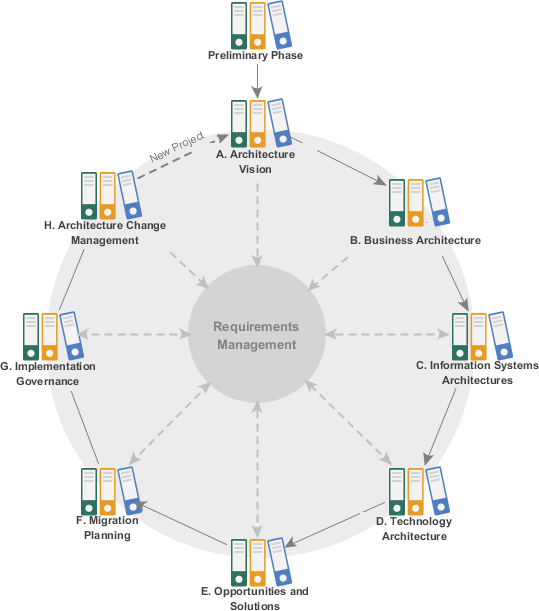
Step 2: Open the TOGAF ADM Preliminary Phase
We will now begin with the first phase of the TOGAF ADM cycle, the Preliminary phase.
- To open this phase, double-click on Preliminary Phase in the ADM cycle (as shown in the figure above), which will display a process diagram containing the necessary activities for this phase. The content of the Preliminary phase is illustrated in the figure below.
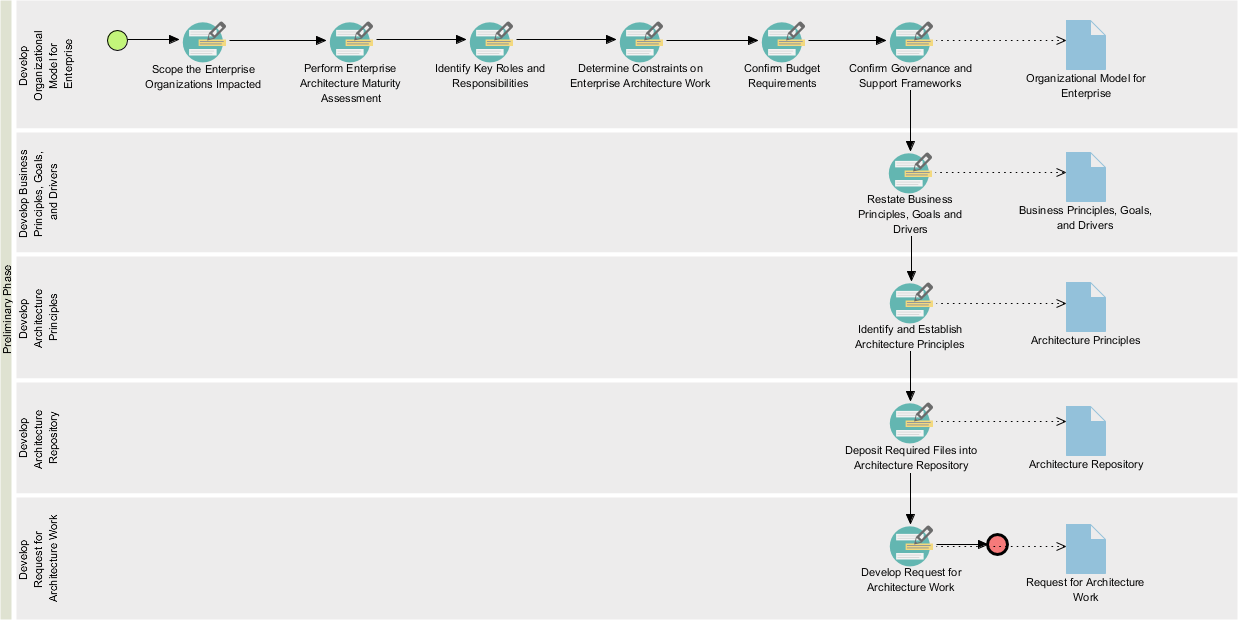
Step 3: Select the activity to work on with
Each phase of the TOGAF ADM requires you to carry out specific activities in order to produce the necessary deliverables. In the process diagram, these activities are represented by interconnected shapes, with the arrow connectors indicating the flow between them. It is important to follow this flow in order to complete each phase correctly.
- To begin, double-click on the Scope the Enterprise Organizations Impacted activity.

- The following screen will appear, presenting the steps required to complete the activity, listed under the Overview section. As shown in the figure below, this particular activity contains two steps.
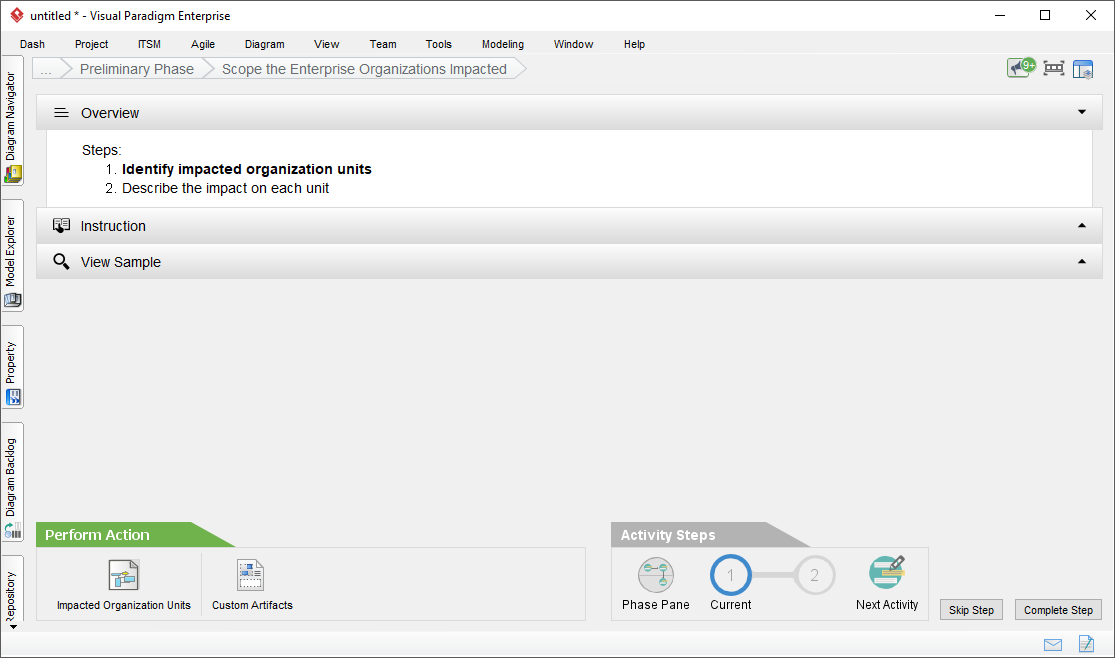 Here is a brief description of the different elements on this screen. We will cover each of these in more detail in the rest of this TOGAF tutorial.:
Here is a brief description of the different elements on this screen. We will cover each of these in more detail in the rest of this TOGAF tutorial.:
- Overview: This section outlines the steps needed to complete the activity. The current step is highlighted in bold. Once you have finished a step, click the “Complete Step” button at the bottom right corner to move on to the next step.
- Instruction: Click on this section to expand it and view information about the current step. This includes what you need to do, the purpose of the step, and what you will achieve.
- View Sample: Click on this section to expand it and view any samples associated with the current step. For example, if the step requires you to create a specific type of diagram that you are not familiar with, you can view a sample to gain an idea of how the diagram should look.
- Perform Action: This section outlines the action(s) required to complete the current step. There may be one or more actions listed. If you want to include your own text or diagrams in addition to what is recommended, you can click the “Custom Artifacts” button to add them manually. For example, step 1 may require you to write a project background and draw a diagram to depict it. Step 2 will have its own set of actions.
- Activity Steps: This section indicates the progress and completeness of the activity.
- To help you complete the required actions, we provide detailed instructions and examples for each step. It is advisable to read through them before taking any action. You can expand the Instruction section to access the instructions.
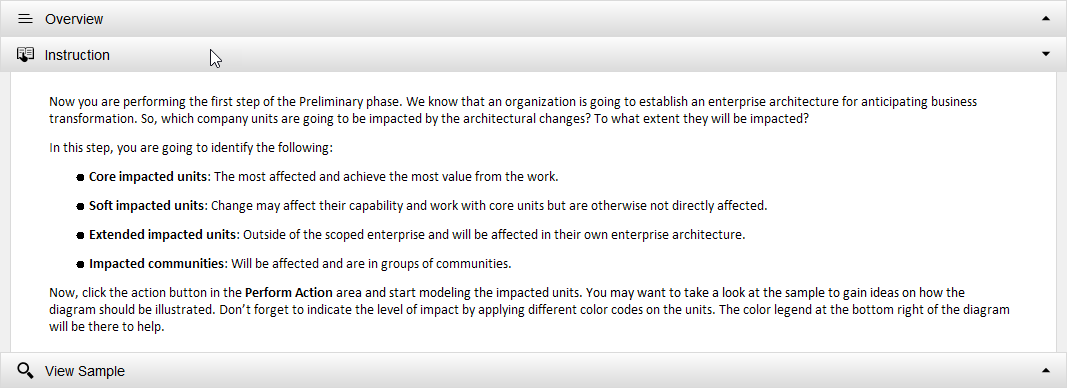
- Besides, you can expand the View Sample section to see the sample provided. For instance, in this step, the sample provided is an ArchiMate Diagram, and you can create your own by following the instructions and viewing the sample.
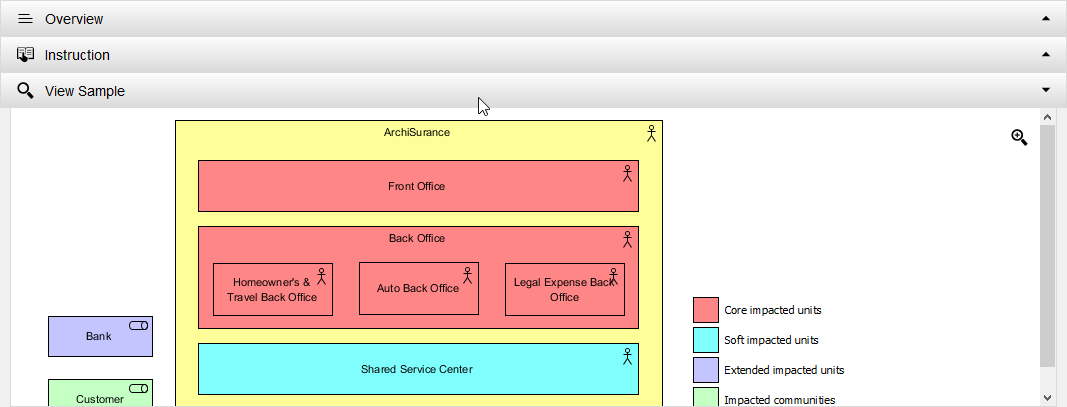
- Once you are ready, click on the action button Impacted Organization Units listed under the Perform Action section. Note that some steps may have multiple actions, and you must complete all of them.

Note: You can also use the Custom Artifacts button to include optional diagrams or text data in the deliverable to be produced.
- You are presented a new, empty ArchiMate diagram. This step requires you to use the legend at the bottom right of the diagram to draw an ArchiMate diagram that shows the impacted units. Let’s draw a Location first. Select Location in the legend.
- When you click on the action button, you will be presented with a new, empty ArchiMate diagram. For example, in this step, you are required to draw an ArchiMate diagram that shows the impacted units. To do this, you need to use the legend at the bottom right of the diagram to draw the necessary elements. Select Location in the legend.
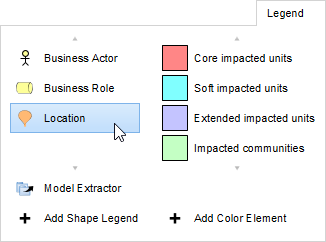
- Draw a Location in the diagram and name it Area 1.
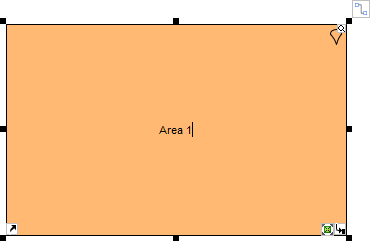
- Apply the same technique to draw a diagram that looks like this:
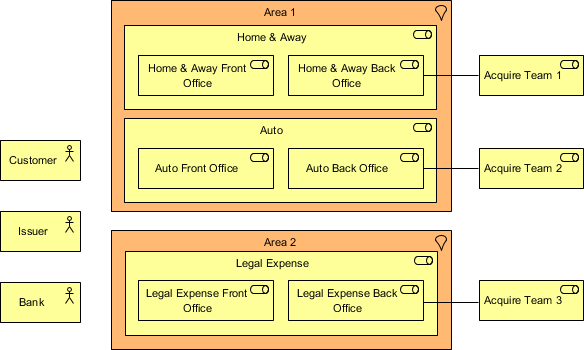
- Once you have completed drawing the necessary elements, you can indicate the level of impact on individual units by selecting Core impacted units in the legend and clicking once on the unit with core impact.
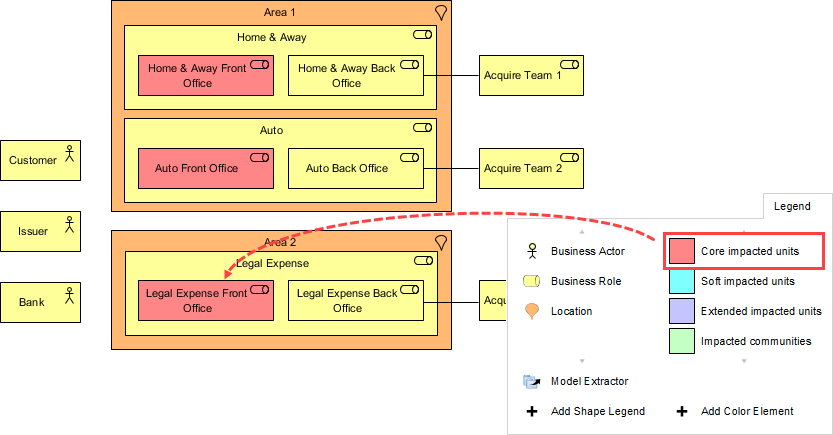
- Indicate the level of impacts on other units, following the instructions provided. The completed diagram should look like this:
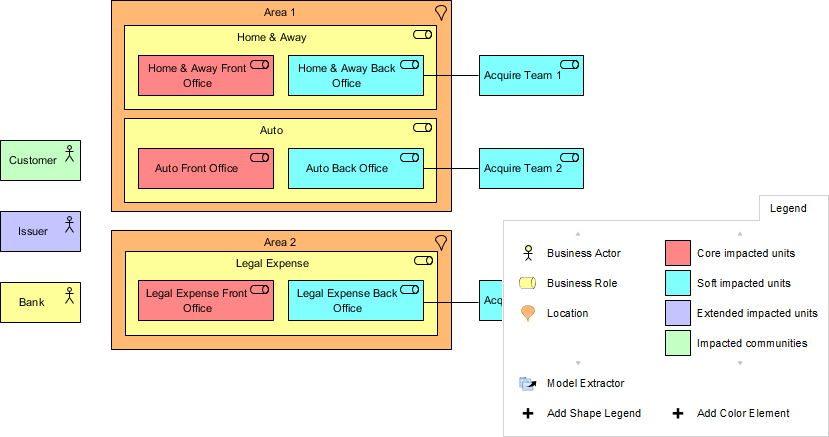
- After completing the diagram, you can go back to the activity screen by clicking on the breadcrumb.

- Once you have finished this step, click on the Complete Step button at the bottom right to proceed to the next step.

- You are brought to step 2.

- Step 2 requires describing the impacts in detail. Click on the action item Description of Impacts under the Perform Action section.

- Complete this step by filling in the form.
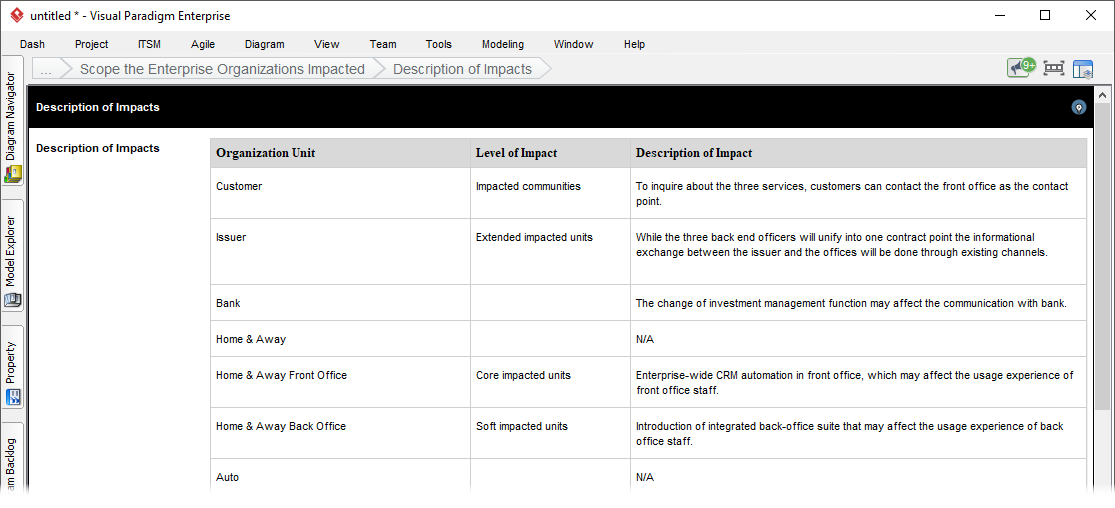
You may use the sample content below:Organization Unit Level of Impact Description of Impact Customer Impacted communities To inquire about the three services, customers can contact the front office as the contact point. Issuer Extended impacted units While the three back end officers will unify into one contract point the informational exchange between the issuer and the offices will be done through existing channels. Bank The change of investment management function may affect the communication with bank. Home & Away N/A Home & Away Front Office Core impacted units Enterprise-wide CRM automation in front office, which may affect the usage experience of front office staff. Home & Away Back Office Soft impacted units Introduction of integrated back-office suite that may affect the usage experience of back office staff. Auto N/A Auto Front Office Core impacted units ArchiSurance is going to provide a one-stop shop solution for its customers by unifying the three front offices into one single point of contact for all three major type of products and services. Auto Back Office Soft impacted units Introduction of integrated back-office suite that may affect the usage experience of back office staff. Legal Expense N/A Legal Expense Front Office Core impacted units Enterprise-wide CRM automation in front office, which may affect the usage experience of front office staff. Legal Expense Back Office Soft impacted units Introduction of integrated back-office suite that may affect the usage experience of back office staff. Acquire Team 1 Soft impacted units N/A Acquire Team 2 Soft impacted units N/A Acquire Team 3 Soft impacted units N/A Area 1 N/A Area 2 N/A - Go back to the activity page through the breadcrumb.
- Click Complete Step at bottom right.

- The steps under this activity are all done. You may move on to the next activity by clicking on Next Activity under the Activity Steps section, but let’s try something different. Click on Phase Pane under Activity Steps.

You are brought to the process diagram of the preliminary phase. You can see a check mark next to the activity Scope the Enterprise Organizations Impacted, indicating its completion.
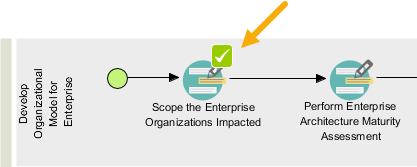
- Now, let’s perform the next activity. Double click on the activity Perform Enterprise Architecture Maturity Assessment to open it.

- Click on the action item Architecture Maturity Assessment.

- For this activity, you will need to conduct a maturity analysis. Utilize the methods you have acquired thus far to construct the following chart for Step 1. If necessary, you may change the name of a maturity factor (e.g., Goal, Organization, Strategy) by double-clicking on it and entering a new name. You may also add a new factor by right-clicking on the chart and selecting Add Variable from the drop-down menu.
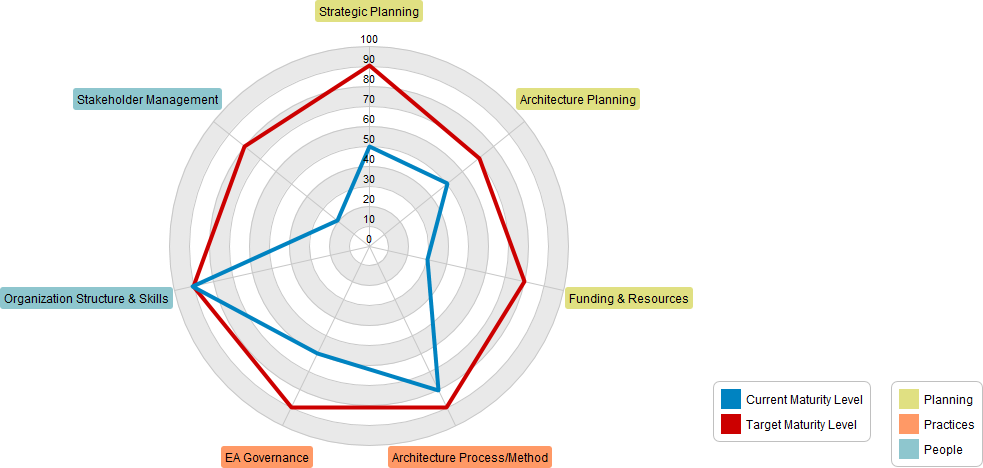
- Go back to the activity page through the breadcrumb.
- Click Complete Step at bottom right.
- Step two requires reviewing the maturity gaps. Click on the action Maturity Gaps and Resolutions, take a look and go back to the activity page.
- Click Complete Step at bottom right. So you should now have a basic idea about how to use Visual Paradigm to develop enterprise architecture. We will just stop here.
Step 4: Generating an ADM Deliverable
Once you’ve completed all the activities in a (deliverable) lane, you can generate the deliverable. To generate a TOGAF ADM deliverable is simple, you just need to double-click on the document shape on the right-hand side of the lane.
Once all the activities in a deliverable lane are completed, you can easily generate the corresponding deliverable. Simply double-click on the document shape located on the right-hand side of the lane.

Then, provide a name for the file when prompted. The generated document will include all the diagrams, forms, and content that you have developed and filled in.
For example, the first figure below displays an ArchiMate Diagram that was created, while the second figure shows an architecture maturity model that was developed using a radar chart:
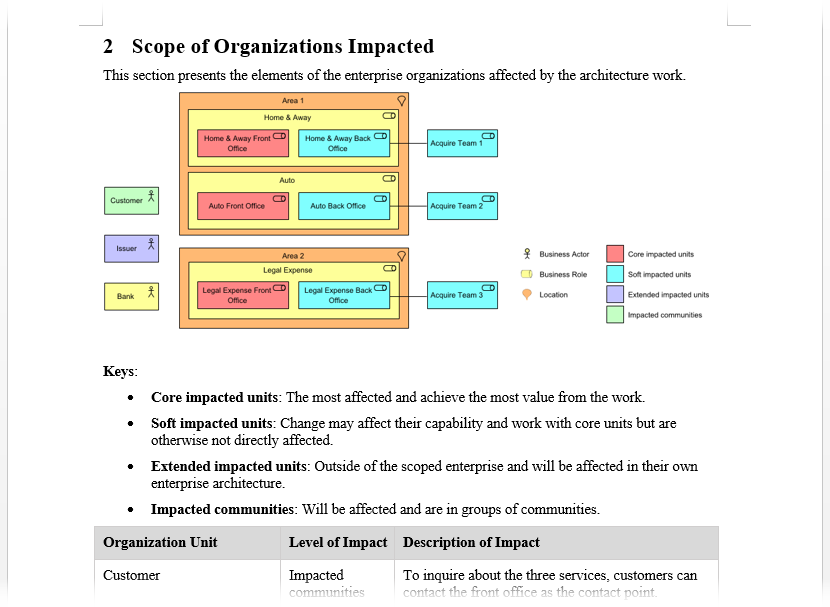
And here is the architecture maturity model developed using radar chart:
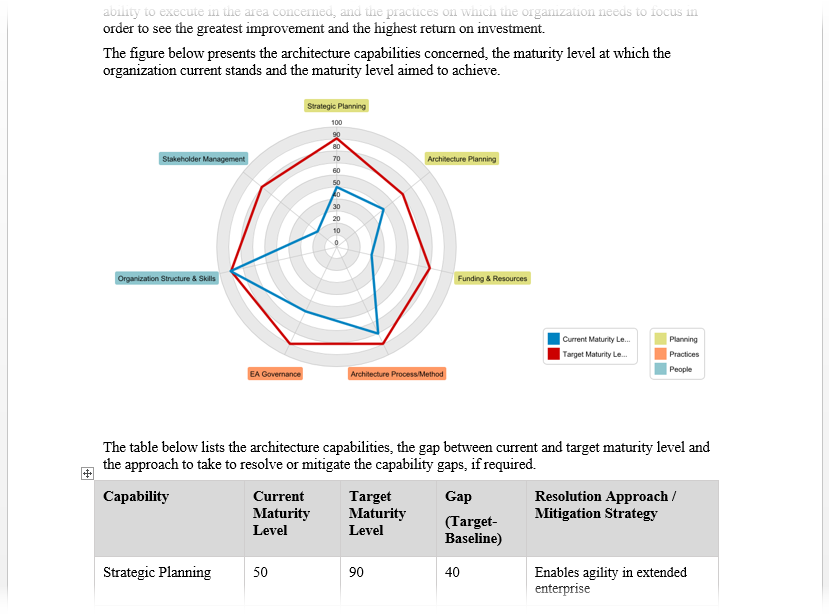
Using the Architecture Repository
The Architecture Repository serves as a centralized location for all the architectural assets within an organization. Whenever you create a deliverable, a duplicate copy of it is automatically stored in the Architecture Repository. To access the Architecture Repository, navigate to the application toolbar and select ITSM > Architecture Repository.

In the following image, you can see the layout of the Architecture Repository. Once all the activities associated with a TOGAF ADM deliverable are completed, the deliverable (document) will be automatically generated and saved in the Organization-Specific Architectures drawer. To view the deliverable, simply double-click on the drawer and retrieve the document.
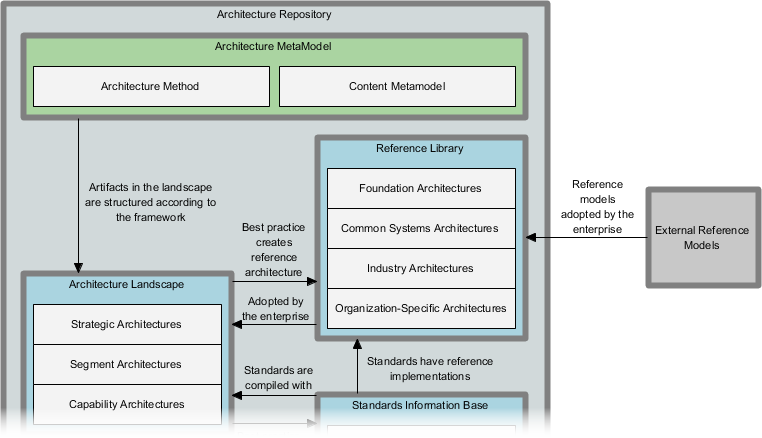
In addition to automatically storing deliverables, the Architecture Repository also allows you to manage and store your own files. To store a file, simply drag it into the Architecture Repository and drop it into the appropriate drawer.
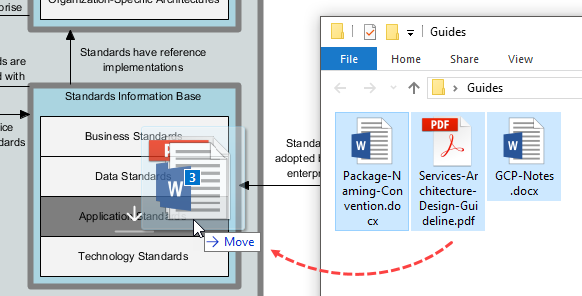
Conclusion
In this tutorial, we have explored the fundamentals of the TOGAF ADM, a framework for enterprise architecture development and management. We have learned about the use of Visual Paradigm to implement the ADM.
By following this tutorial, you should have a good understanding of the TOGAF ADM and the TOGAF ADM tool, and be able to apply them in your own enterprise architecture practice.
We hope that you have found this tutorial to be a valuable resource!

